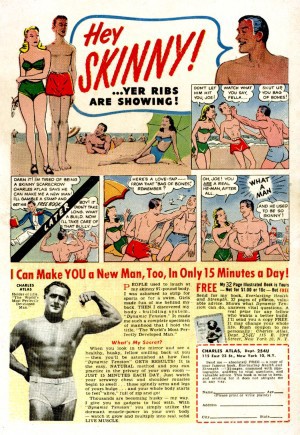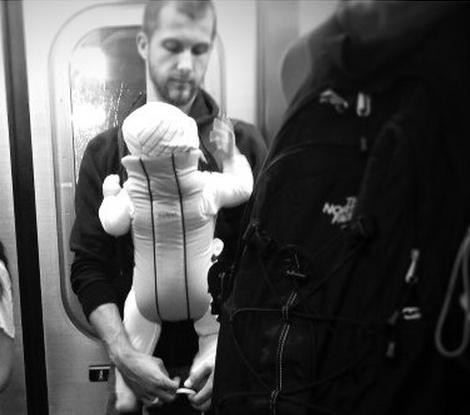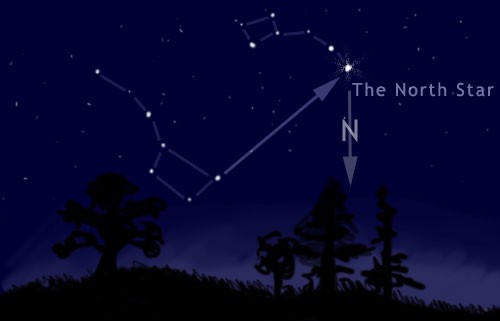Your Eyes Are Gay-Detecting Machines
“People have an inbuilt ‘gaydar’, which enables them to judge in the blink of an eye whether someone is gay or straight, a study at the University of Washington has found. And it is easier to judge a woman’s sexuality than a man’s — just from glancing at them.”
When and What Do Guys Think About Pants? An Investigation

Content series are produced in partnership with our sponsors. Up first: Pants! Brought to you by Life Khaki from Haggar.
Over the weekend I went to the Lehigh Valley Mall. It’s just outside of Allentown, Pennsylvania, and would rank as the most popular (and second-most swanky) of the malls in the region. It’s standard-issue, two-levels, lacking a proper food court (although it does have what they call a “lifestyle center,” which was added in 2007, and which is basically a strip-mall add-on with stores slightly more upscale than the ones inside).
Recently I have become concerned about my own wardrobe. I have been somewhere just north of a slob, pretty much always wearing blue jeans, a t-shirt and a button-up over it. Unless it’s the summer: then the jeans get swapped out for a pair of cargo shorts. I never really gave it much thought (obviously), but recently have been forced to reevaluate after a small blow to my vanity. I’m growing up. So I went to the mall.
The standard-issue enclosed shopping mall hasn’t changed much since its popularization in the 60s. They are uniform, convenient in their climate control and their stacked arrays of retail concerns and their vast seas of asphalt on which to park, cemented into popular culture by
one thing or the other, depending on your demographic. I grew up in them like everyone else in the suburbs, and the Lehigh Valley Mall is no different than the malls of my youth, which was not making it any easier to figure out which dudes to talk to about pants.
The inciting incident regarding my vanity, between you and me, was an acquaintance, having heard that I once acted in plays, asking if I’d be game to audition for a show. Tempted, I asked to see a synopsis of the production, and quickly realized that I was a candidate for a character described as “fat and balding.” Now, I may be above my optimum weight, and there’s a big difference between thinning hair and baldness, but whatever, vanity wounded! Time to start to get my business correct.
The problem was, how to go about my business and getting it correct?
Starting with pants was a no-brainer. Shirts, I have some that I like, that make me look good (or at least feel like I look good), shirts for dress, shirts for working, shirts for gadding about. Pants are another issue entirely. I never thought that I was shaped unusually, but the pants manufacturers of the world have convinced me otherwise, as I have very rarely encountered pants that have fit me like they are supposed to. Either the seat is drooping off me or I’m rolling them up or the fly hangs down to somewhere mid-thigh. Not that I’d given it too much thought — no, it was a mild nag, maybe one that I’d assumed was just how things were supposed to be, that some fellows were just born to have their pants make them look like a hamper.
I thought about asking my very stylish wife for advice, but that would break down into me expecting her to confirm my utter attractiveness and then getting my feelings all inadvertently hurt. I could ask friends, but that could blow up into a Fashion Intervention worthy only of cheap sitcoms. I’ve had a subscription to Esquire for years, but to actually turn to the clotheshorse pages would feel like betrayal. I wasn’t looking to stand out; I was looking to fit in, for once.
I needed to talk to dudes: to sharply dressed dudes.
It was about lunchtime on a Saturday, and I was confident that finding the right guys to talk to about pants at the mall would be a cinch. Surely a bunch of kempt fellows would be lounging around the railing on the second floor, or sitting together and munching on snacks. Who doesn’t love talking to a journalist? Or at least a guy pretending to be a journalist.
“Excuse me,” I’d say, whenever I found a dude in pants, “I’m a reporter working on a story about… clothing. Do you have a minute to answer a couple of questions?” They each perked up at the word “reporter,” but then each withered when the topic was revealed. They tried to answer questions honestly.
Here are some highlights:
• The number of pairs of pants owned by the average guy? Single digits, ranging from 2 to 9, except for: “I don’t get a lot of clothes, so, like, ten.”
• Hey, dude with the Van Dyke, do you spend a lot of time thinking about pants? “Not really.”
• Of all the things these guys care about, how much thought is given to pants? That got a big blank stare that required some prompting: “Toward the top? Towards the middle?”
• How does the average guy know when to get a new pair of pants? “Whenever I feel like it. It depends on my mood.”
• Hey, guy with only jeans and shorts in your wardrobe, what do you do for weddings and funerals? “I usually go out and shop, for, like, a special occasion.”
The best brief interview conducted was with Dylan, who was 19, and who I ambushed as he passed the American Eagle Outfitters. He was happy to chat. Although, he was embarking on a summer job as a landscaper, so his opinions on pants were pretty practical in nature. “But do you have nice pants, you know, for going out?” Not so much. Every time I thanked them and wished them a nice afternoon, and clicked off the recorder as I jotted down their name/description, it felt like I was losing.
But all along I wasn’t really working on a story. I was looking for tips, for consensus. There were a couple guys that seemed like they would’ve been receptive if not voluble, but frankly, I didn’t like how they were dressed. There was the dad and his twenty-something son, laden with bags from Boscov’s, but they were both in shorts and tees. There were two guys loitering in front of the FYE, but again in shorts, and not just T-shirts, but heavy metal T-shirts. How would the story benefit from dudes dressed as bad or worse than I dress? Scratch that, how was I supposed to learn something, is what I meant. The two separate guys I talked to who were stationed at kiosks fit the bill, almost, but they were admittedly on the dress code clock.
And I’d asked if they thought that the word pants was funny, to (clumsily) lure them into a more free-flowing conversation. Think about it: David Letterman’s production company, Worldwide Pants, the caustic yet dismissive nickname assigned to Umar Farouk Abdulmutallab (the Underpants Bomber) — it’s truly a funny word, especially compared to trousers. But sadly the question was interpreted more like part of a quiz than an occasion to open up.
My mission, talking to dudes in a mall about pants, was not at all a failure. It was, in fact, instructive. What have we learned? That I was not alone in being someone who is not taking his pants as seriously as maybe he should be. That there are many other dudes out there in the same boat. That dudes are not used to talking to dudes about their concerns about their pants. These seem like things that should change. At least, this is all true outside of Allentown, Pennsylvania, in the general vicinity of the Lehigh Valley Mall and its connected lifestyle center.
This content was created for our partner Life Khaki from Haggar.
Photo by Conrado, via Shutterstock
Man On, About, Against the Internet
Facebook still figuring out their business model.Hope they nail it by Friday.
— Andrew Keen (@ajkeen) May 16, 2012
“Andrew Keen is a smooth-talking hired gun who blankets the country warning conference rooms full of middle managers about the straw-men dangers that await them if they share with one another too freely.”
Cilantro Dissidents Identified
“[W]hen a study of identical twins found an aversion to cilantro stems from a genetic glitch, the herb’s bashers finally had a good reason why they found the leaves of the Coriander plant so offensive. But who are these people in the anti-cilantro community? No one had a clue — until now.”
The Bodybuilder's Guide To Getting Rid Of "Computer Back"

Do you suffer Computer Back? I do. Mine is caused by the terrible habit of hunching over the laptop while also curling my legs under the chair in a sort of corkscrewed position that is osteomuscularly nightmarish but somehow conducive to concentration. When I stand up I look like a stooped, slightly concerned turtle. Now, lots of people have Computer Back, and nearly everybody with whom I’ve talked about it has, at some point in the conversation, brought up the fact that Philip Roth works at a standing desk. That tidbit, you’ll remember, came out in a 2000 David Remnick profile, and it apparently haunts the imagination of everyone with a computer-related job who read it.
Roth wakes early and, seven days a week, walks fifty yards or so to a two-room studio. The front room is outfitted with a fireplace, a desk, and a computer set up on a kind of lecturn where he can write standing up, the better to preserve a bad back.
That The New Yorker included no diagrams or ordering information seems like an oversight/ lost opportunity on somebody’s part. But if you’re interested, here’s an option that might suit, and here are some others. (A standing desk also has the benefit of keeping you from dying from “sitting disease.”)
If that’s not for you, what else to do? Obviously, sit and stand up straighter, but when things have gotten really crinkled, who can remember what good posture even feels like? Emailing about this with writer Lili Loofbourow (“let’s talk about ailments!”), she directed me to some ace advice she’d found at a bodybuilding forum, and I share it now in the spirit of a Computer Back PSA.
The original poster had asked the forum for advice about rolled-forward shoulders, aka Computer Back symptom #1, although I think he earned his rolled-forward shoulders from working out too much, not from dweebing around the internet.
One respondent answered with this, which, if you know absolutely nothing about weight-lifting, sounds wonderfully deep and life-coach-ish:
1. reduce the number of pushing exercises
2. increase number of pulling exercises
Another respondent added this chunk of advice (I’ve boiled it down a little, so you should click through if you want the full response):
Roll up a towel and lay down with it traveling lengthwise on your spine. Let gravity pull your shoulders back. You can even sleep like this if you can set it up to where you’re comfortable enough. …
Do lower trap work. My favorite is the hitchhiker. Lay on your stomach on the ground and make sure you have plenty of room. Now put your arms out to your side so you look like a T. Then, externally rotate your hands so your thumbs are pointing at the ceiling. Now, squeeze your shoulder blades together, lift your arms up off the ground and move them towards each other. Stop when you resemble a Y. Now hold for a second or two and move back. Very easy and you should feel this pain start pretty quickly in between your shoulder blades.
You should try to squeeze your scapulae together when you walk or sit. It’s really hard at first and it caused me to cramp up but I personally believe it accelerated my healing from a month to a week. In any case, even if you can’t do it now you’ll have to progress to it because having proper posture involves active muscle usage. Think about it: you always suck your abs in to tighten them when you walk… at first it was something you consciously did but now it’s subconscious. It will take a while, but you will soon subconsciously pull your shoulders back.
Back to the pull more/ push less advice. A friend who competes in Strong Man competitions shared this list of pull exercises that, if you’re a gym-goer, you can add to your routine:
• Seated row (any type of rowing action)
• Pull ups
If you’re not a gym-goer, I’d try the lying around on a towel trick and the hitchhiker exercise the second respondent describes. The former sounds good to do midday and ending in a relaxing, posture-improving nap. Also, for the female Blume-ites among you: The other day I was out for a walk and, while “squeezing the scapulae” and thinking about “pull, not push,” realized that “We must, we must, we must increase our bust” chant from Are You There God? It’s Me, Margaret should also help with Computer Back. The bodybuilders didn’t mention it, but it’s obviously a very worthwhile exercise, because it’s easy, doesn’t require equipment and lets you think about Judy Blume. So if you used to do the “We must, we must” thing in fifth grade, now is the time to resume, just for entirely different reasons than you used to have.
Feminist Australian
“What I want her to do is get rid of those bloody jackets. Every time she turns around you’ve got that strange horizontal crease, which means they’re cut too narrow in the hips. You’ve got a big arse, Julia. Just get on with it.”
— Feminist hero Germaine Greer speaks truth to power while discussing Australian Prime Minister Julia Gillard.
Future Brooklyn: The Dadvorcé Mancave

Good news! I ran into a bunch of married Brooklyn dads last night (in Manhattan, of course), who weren’t so happy about our thoughts on how the real estate needs of their upcoming divorces are going to destroy whole swaths of gentrified Brooklyn.
But the disgruntled dads did bring up something obvious I hadn’t considered. What do you think the likely behavior of a bunch of 40-something dadvorcé’s will be? That’s right: dadcaves. They’re not going to live on their own when they get divorced, thereby hogging all the apartments. They’re going to all be roomies! They’ll form packs of bro households, with a high-up wet bar that the kids can’t reach and a Wii in every room. A Frankies cookbook in every kitchen! It’ll be their third boyhood! This, at least, will keep the housing market from being completely flooded by the forthcoming Brooklyn divorce wave. Plus, they’re all going to be living in the new Crown Heights, after it’s gentrified, anyway. That’s too bad, because do you know how hard it is to get from the 3 train to the F train? Commuting from daddy’s Brodown Palace to Mommy’s Lil’ Yoga Retreat in Carroll Gardens is going to be horrible for Parsnip and Carrot, the sad hipster twins of divorce.
(Also obviously: the gay dadvorcé — you know, the ones who were bi and then married a woman and then started dating men again after the divorce — will just move back to Manhattan.)
El-P Raps Live On Letterman
You know you’re doing good when noted rap expert David Letterman exclaims, “You got something there.” If this performance is any indication, El-P’s new album, Cancer 4 Cure, will be something to get when it comes out next week, and the concert tour that he announced yesterday ought to be a barn-burner.
How To Get Lost Less Often
How To Get Lost Less Often

No one’s supposed to get lost these days. Smartphones have maps on them — and compasses, too. But phones have a way of losing their signals when you most need them, and then there are the times you simply can’t figure out which street on a crowded map that flipping little blue dot is indicating. And then sometimes your phone dies, and who knew you can’t bike through there, and oh god, the left pedal fell off — and suddenly you’re meeting your boyfriend’s family two hours late and covered in sweat because you took the long way around Arlington Cemetery. Hypothetically.
Or let’s say, you just have a really, really lousy sense of direction, and no phone or GPS system made yet can help you. That’s fine! Lots of people don’t have a great one. But if it makes you tense to be lost or late and you’d like to get better, well, there are ways to actually improve your sense of direction. I know — I’ve done it myself. I’ll tell you how, and after that, just for fun, let’s look at five situations where people frequently find themselves lost and beyond the help of technology — giant parking lots, wandering from a tent at night, walking around a foreign city, or while stuck in a giant corn maze (as sometimes happens) — and explore some ways to orient yourself there.
TIPS FOR IMPROVING YOUR SENSE OF DIRECTION
To flagrantly pilfer the title of a John McPhee classic, the basis of a good sense of direction is having a sense of where you are. So at the most basic level: Look around you and pay attention to the landmarks where you live. Collect them, and note where they are in relation to one another. Once you have collected enough, it becomes a great way to navigate around town. Remembering to “turn left when you get to the place with all the lawn flamingos” will connect in your brain the way “go .3 miles then head north” never will. I like to picture that I’m engaging with a 1:1 scale map and visualize my surroundings from above — that megachurch a block west gets a little sans-serif t, the park up ahead a big block of pale green. So when I’m moving around I have a sense of where I am in relation to where I came from and where I need to be. I am a little blue dot, bleeping my way across town.
When you’re going somewhere new, spend some time with Google Street View and practice your routes. Visually familiarize yourself with, say, the path from the train station to your friend’s house, or your hotel to that cute breakfast place. Then, if you’re going to stay in that new place a while, start collecting landmarks there. I once moved overseas for a short-term work situation, and my first landmark there was a cracked wall that a car had driven into. That wall marked the exact spot that I needed to pull the Stop Requested cord on the bus. By the time the wall was patched up, it was instinct. Also — and this is ideal, if you can swing it — I made a good friend there, a local with a deep knowledge of the area that he was thrilled to share. His stories made the unfamiliar neighborhoods come to memorable life — the overpass a truck got wedged underneath, the curry place that gives everyone food poisoning, the haunted graveyard — locations were given a personal meaning, and I could find my way around solo by remembering his descriptions.
In everyday life, though, I carry a notebook and a writing utensil all the time (this one!). Why not? It takes up almost no space. The paper is more important than the pen here: I’ve taken notes in highlighter, lipstick, even bbq sauce on a toothpick (grass stains, no matter how carefully applied, do not work, FYI). Believe me, you are almost certainly going to smear that address off your hand, so best to write it down somewhere safe (and unsweaty). And do this before you leave the house: you might not have a signal or your phone might die or you might straight up forget where you’re going. I once tried to attend a GIS meetup at a D.C. bar called the Saloon once, but it turned out it was at Stetson’s. Yes, I was late to a geographers’ happy hour because I was at the wrong place. Irony! The point is, knowing vague details (“it’s the western-sounding bar that starts with S on U St”) is not always enough — write it down.
If you’re really serious about wanting to improve your sense of direction and don’t mind dedicating some effort into it, practice makes perfect. Try orienteering! It is, essentially, competitive map reading, and it is a blast. Straight from the US Orienteering website: “In orienteering, you use a map and a compass to locate a series of checkpoints shown on a specialized topo map, choosing routes — on or off trail — that will help you find all the points and get to the finish in the shortest amount of time.” And you know, it’s not even work. I did it once and can recommend it as a possible fun afternoon date, or with friends. And your improved map reading all but guarantees you the navigator front seat on road trips.
But then there are the situations where even a good sense of direction may not be enough or where technology may fail you. The advice here may totally seem like common sense, I know! But dumb things happen to everyone, so you may as well be prepared.
1. A PARKING LOT
Years and years ago, my family went to the mall for some holiday shopping, typical enough, only when we emerged, the minivan was not parked in the usual area. We had a very distinctive van at that point — maroon with a pink lightning bolt down the side — and so if we couldn’t find it, it had to have been stolen. My mom immediately and logically called the police. The nicest cop in the world showed up and gently suggested to my by-then panicky mother that we take a drive around the parking lot — sure enough, it was on the other side of the mall, right where we’d left it. He said it happened at least once a week. We hadn’t parked in the usual location‐the one by the food court (there are always open spots there! Why is that? I guess no one goes to the mall to eat) — because we had to return something heavy.
A little existential backtracking is your friend here: why are you here? Well, a little less existential: why did you go to the mall? The primary impetus for the trip was probably your first stop, and that’ll be where you parked. If that doesn’t work, check the times on your receipts, and investigate the parking area closest to the first store. (Of course, too, if the lot areas are marked, like in a parking garage or amusement park, and you noticed that when you arrived and you’re carrying that notepad…)
2. AT NIGHT

Okay: I’m not a wilderness expert — let’s be clear. I don’t want some desiccated corpse found somewhere, last words scrawled in the dirt beside it VICKY TOLD ME TO GO THIS WA — -, but navigation by star position is simple enough, and it can be a nice activity on a camping trip, try to get your bearings that way. First: locate the North Star/Polaris, shown here. Then find Orion. The rightmost star in Orion’s belt, Mintaka, will always be within one degree of true East (before midnight) or West (after). Using these two stars as your guide, create a mental compass.
In the southern hemisphere, you’ll do basically the same thing with the Southern Cross.
It can be fun to practice with this, and everyone can use a little extra stargazing every now and then. Then if sometime you, say, stumble off into the woods to pee and can’t find your campsite again? Using stars as guide points will prevent you from walking in circles as long as you keep referencing them as you walk. But hey, if you have no star sense and/or it’s cloudy, FFS, it’s dark out — you can pee within sight of the tent. No one will know.
3. A STRANGE CITY
For me, the strange city was Myslenice, Poland, and, as I was a teaching assistant for an English immersion program, it mostly didn’t matter that I only know about ten words of Polish: cusses, names of foods, and “Happy New Year!” None of which are helpful when you’re lost. But all alone and about to miss the midday meal, I blurted “Proszę, szkół?” (May or may not mean “Please, school?”) to a friendly-looking gentleman… and was sent in the opposite direction. Here’s the thing, he clearly did not understand what I was trying to convey. But people are kind, and they want to assist someone who looks distressed.
This happens. In most cases, folks are not going to be intentionally malicious, they just want to help. But not all are good at it, or you may have just said something horribly garbled. So if you’re not for whatever reason confident in the direction giver, ask a few more people — try to get a general consensus. The direction that most of them send you in? That’s likely the direction you should go. This is also, by the way, a good time to have where you’re going written down on paper. If I had been able to show that guy “Szkoła dla głuchego” written out, I probably would not have missed the chłodnik. Mmmm, chłodnik.
Side note: Many American cities have a regular grid pattern with numbered streets, but that’s not true everywhere. Older towns and cities, for example, tend to have centrally located town squares. The major streets will lead outward from the square, and hopefully one of them will have a name you recognize. There’s also likely to be some official presence there, someone whose job it is, in part, to wrangle the directionless.
4. UNFORESEEN DETOUR
So that hypothetical situation about being two hours late to meet a boyfriend’s family? Of course that was me, I’m terrible at coming up with hypotheticals. And if you’re at all familiar with the national capital region, I was biking from Park View, DC, to Del Ray, VA. Google Maps, whose reminder that bike routes are in beta I habitually ignore, sent me through Arlington Cemetery. Did you know that you can’t ride a bike through there? I think it’s the only time I’ve ever had a gun drawn at me. But my phone was dead, my bike was literally falling apart, it was about to rain, and that whole area was as familiar to me as the back of your hand. I was hosed. The best you can do in this situation — or in any similar mess — is use context clues — listen for sirens if you know of a hospital in the area, streets with North and South directionals, anything. In the absence of context clues, backtrack along the exact route you took until you get to a familiar location and reevaluate from there. My context clue was the airport. I knew where National Airport was in relation to where I was and where I wanted to go, so I could roughly triangulate my position by watching planes begin their descent. I backtracked to the bridge over which I crossed the Potomac, where I was able to find the entrance to the Mt Vernon trail, which [side-eye to Google Maps] I should have taken in the first place.
5. LOST IN A CORN MAZE

Okay, so the point of a corn maze is to get lost. Yes. But eventually you have to leave. For this one I actually called a few farms with seasonal corn mazes, and the one that got back to me refused to divulge their secrets. Is corn maze design a secretly cutthroat industry? Anyway: here’s what you should do should you be hopelessly adrift in a sea of stalks: turn left. Corn mazes are designed to trick participants, and studies have shown that most humans will naturally, when confronted with a fork in the road, turn right; the hour I spent last night testing this on satellite images of corn and hedge mazes absolutely proves that clever maze-makers love to play on your instincts. (Side note: I’ve heard that that turning-left tip is also a good strategy for avoiding long lines at amusement parks.) You can also plow through the stalks, but that kind of ruins it for everyone. And hey, if it really comes down to it, you wouldn’t be the first to have called 911.
Previously: The Maps We Wandered Into As Kids and A Reading List For People Who Love Learning About The World
Victoria Johnson is a cartographer. She just added ‘design a corn maze’ to her bucket list. Photo by jason.kuffer.
